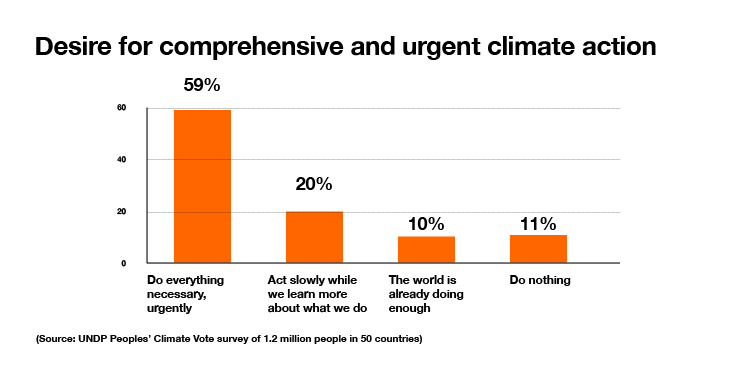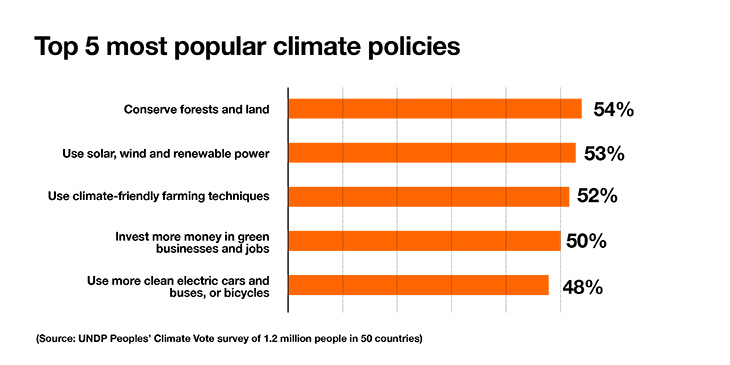Recent research by the UN Development Programme (UNDP) questioned 1.2 million people in 50 countries and found that two-thirds of people think climate change is a global emergency. “The voice of the people is clear – they want action on climate change,” commented Cassie Flynn, the UNDP’s strategic adviser on climate change.
The need for urgent action was echoed at the World Economic Forum in Davos. Voices as diverse as Greta Thunberg and Prince Charles spoke of the need for business leaders to do more to fight climate change. UN Secretary-General António Guterres highlighted the pivotal role the private sector must play in powering a sustainable recovery from COVID-19. This follows the USA rejoining the Paris Agreement on climate change.
Consumers’ buying decisions are changing. A recent National Retail Federation survey of North American consumers found that 70% think it is important that a brand is sustainable or eco-friendly. Over half the survey respondents said they are ready to change their shopping habits to reduce their negative impact on the environment. Citizens and consumers are now demanding companies be more ethical and work towards net-zero carbon emission targets.
What is net-zero?
Net-zero refers to achieving a balance between emissions produced and emissions taken out of the atmosphere. Many large tech companies have committed to becoming net-zero organizations, most of them by 2050. Orange has set the ambitious target, in line with the Paris Climate Agreement, of net-zero carbon emissions by 2040.
Companies seem to be recognizing the urgency of the issue and responding. The number of companies registering net-zero emissions commitments doubled in 2020, even in the face of COVID-19, as many companies factored climate action into their business recovery plans.

Major motivations for companies to be net-zero
First, the ethical reason. Human activity is causing climate change, and companies are part of that equation. Emissions have continued to increase, leading to global warming of one degree Celsius above pre-industrial levels. Merely reducing carbon emissions is no longer enough to reverse the trend: we now need to achieve a net-zero future to stop emissions growth altogether.
Second, net-zero makes business sense. Customers now demand the companies they buy from are committed to sustainability. Three-quarters of Millennials are changing their purchasing habits to reduce their impact on the environment, compared to 34% of Baby Boomers. Furthermore, 54% of Generation Z and 50% of Millennials say that they are willing to pay an extra 10% or more for sustainable products. Being a net-zero company makes you more attractive to consumers, ethical and social governance (ESG) investors, and talented job seekers.
Further to this, there are other compelling business reasons for reducing energy consumption. As the price of water, energy and other inputs increases and regulation intensifies, costs will go up and likely make supply unpredictable. If you focus on keeping costs down and reducing your energy requirements, you have a more sustainable business model.
There’s even the simple incentive of making your company synonymous with business success via sustainability. Tesla is an example of a company that has taken a green model and is now one of the world’s most valuable brands. Every electric vehicle added to the road improves the environment and reduces pollution levels. Chinese manufacturers of photovoltaic cells for solar power have posted big profits in the past few years. There is money to be made by being a green pioneer.
How to drive sustainability
Digital technology accounts for 3.5% of global CO2 emissions, and tech firms have long known they must reduce the environmental impact of networks, data centers and technical sites while still growing. Amazon, Google and Microsoft have used hyperscale to make data center operations more efficient while keeping energy consumption generally steady. A key part of this has been investing in renewable energy innovation to power data centers.
The circular economy is another approach that can bring both sustainability and business benefits. The Judge Business School at Cambridge University has defined the circular economy model as one that “Requires organizations across the value chain to explore adopting disruptive technologies based on improving asset life; adopting mechanisms for reusing, repairing and remanufacturing in the production process. The aim is to put back into the system everything relating to production, distribution and consumption, in order to extract as much value as possible from the resources and materials we utilize. The Circular Economy can be considered as an enabler to achieving overall sustainability in our economy.”
The circular economy approach makes sure that assets are kept in productive use, in a high-value state, for as long as possible. It isn’t a new approach: circular economy as a philosophy has been around since the 1970s, but it is now more commercially viable. Its overall end goal is about reshaping business and economic systems so that waste is “designed out” of daily life.
Circular economy business models can help companies identify new commercial opportunities while contributing to business growth and sustainability. Examples of companies putting circular economy thinking into reality include Royal DSM, which is active in the nutrition, health and sustainable living sectors and employs a circular supplies business. The approach replaces scarce resources with fully renewable, recyclable, or biodegradable resource inputs: in Royal DSM’s case, it has developed a cellulosic bio-ethanol in which agricultural residue (baled corn cobs, husks, leaves and stalks) is converted into renewable fuel. The model created a new source of revenue for DSM while reducing emissions, creating jobs and strengthening national energy security.

Circular product design is an approach that can be both a sustainable and competitive differentiator. Adidas will launch Futurecraft.loop in 2021, its first running shoe that is “made to be remade.” The shoe has been designed with manufacturing and recycling partners so it can be returned to Adidas, broken down, and reused to create new running shoes.
Protix is a Dutch manufacturer and supplier of insect ingredients, and their circular model upcycles food waste into sustainable protein for fish, chicken and pets. The company invested €35 million in an industrial-scale production facility where it uses food waste to breed blackfly larvae, which it harvests to form high-value insect protein products. Protix claims its model forms a “future proof, circular food chain” that can reduce food wastage – potentially saving municipalities money in tipping fees – while also cutting CO2e emissions by tens of thousands of tons per year.
Sustainability and net-zero are a massive job but essential
It has become clear that sustainability and net-zero models are essential. “Build back better” cannot be just another slogan but should serve as a constant reminder that the planet needs a more sustainable future. And if companies want to survive, thrive and recover from recent disruptions, so does business. A huge investment will be required to transition to a net-zero stance, but the rationale is inescapable at this point. Investors are already looking to sustainable companies, and companies, in turn, need to give those investors confidence that targets will be met.
What is Orange doing?
Sustainability is central to the Orange Engage 2025 strategic plan. Further to committing to being a net-zero company by 2040, Orange has also pledged to improve energy use in our buildings and transport systems. Orange buildings, travel and transport make up 20% of the company’s CO2 emissions, so this impact needs to be reduced. Other actions include deploying the largest car-sharing fleet in Europe with 2,540 hybrid and electric cars, which has seen Orange vehicle CO2 emissions reduced by 34% in 12 years. Similarly, Orange deployed a videoconferencing solution at our new EMEA headquarters in Casablanca, which will enable us to reduce travel by 25% by the end of 2021.
Orange is improving the energy efficiency of its networks through a Green IT & Networks initiative. The plan will optimize technical deployments, increase the eco-efficiency of data centers and reduce the energy used by routers. The company is replacing old infrastructure with eco-efficient equipment and using alternative solutions like solar power at Orange sites worldwide.
Lastly, Orange is employing circular economy tactics. too, using reconditioned equipment in networks and data centers. We have targeted 20% reconditioned equipment by 2025 while still delivering a quality of service equal to or greater than present-day levels.